apartment fence design wind load pdf
Wind load is a critical factor in fence design, impacting structural integrity and safety. Understanding its effects ensures fences withstand natural forces, maintaining durability and stability over time.
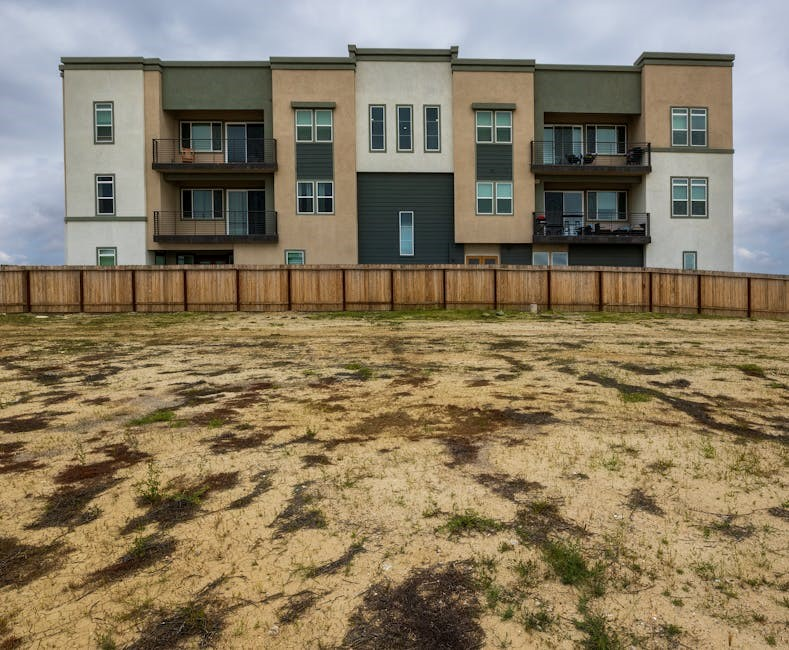
1.1 Understanding the Importance of Wind Load Calculations
Wind load calculations are essential for ensuring the structural integrity and safety of apartment fences. These calculations determine the forces exerted by wind on the fence, helping designers predict potential stress on posts, panels, and foundations. Accurate wind load analysis prevents damage or collapse under extreme weather conditions. Neglecting these calculations can lead to costly repairs or safety hazards. By understanding wind load dynamics, engineers can design fences that withstand various wind speeds and pressures, ensuring durability and stability. This step is critical for compliance with engineering standards and codes, such as Eurocode 1 and ASCE 7-22, which provide guidelines for wind load assessments. Proper calculations ensure fences remain secure and functional over time.
1.2 Overview of Apartment Fence Design Considerations
Apartment fence design involves balancing aesthetics, functionality, and structural safety. Key considerations include material selection, height, mesh size, and post spacing. Durable materials like steel or vinyl are often preferred for longevity. Height and mesh size must align with privacy needs while allowing airflow to reduce wind pressure. Proper post spacing ensures stability, preventing sway or collapse. Foundation depth and concrete footings are crucial for anchoring the fence. Compliance with local building codes and regulations is mandatory. Additionally, environmental factors such as soil type and exposure to wind must be evaluated. A well-designed fence not only enhances the property’s appearance but also provides security and noise reduction, making it a vital component of apartment complexes. These considerations ensure the fence is both functional and resilient against environmental stresses.
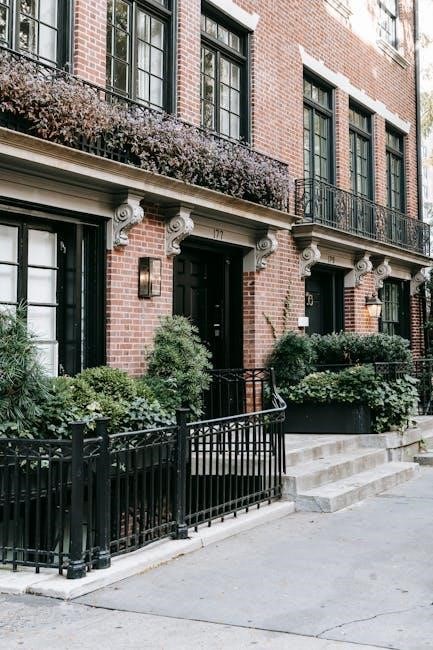
Factors Influencing Wind Load on Apartment Fences
Geographic location, exposure conditions, fence height, material, and surrounding structures significantly impact wind load. Taller fences in open areas face higher wind forces, while materials affect pressure distribution.
2.1 Geographic Location and Exposure Conditions
Geographic location and exposure conditions significantly influence wind load on apartment fences. Coastal areas and open terrains experience higher wind speeds compared to urban or sheltered locations; According to Eurocode 1 and ASCE 7-22, wind load calculations must consider regional wind speeds and terrain categories. Exposure conditions, such as proximity to buildings or natural barriers, alter wind flow patterns. Urban environments may have turbulent winds due to surrounding structures, while rural or coastal areas face more consistent wind pressures. Understanding local wind maps and terrain factors is essential for accurate load calculations. Velocity pressure, a key component in wind load formulas, depends on these geographic and exposure variables, ensuring fences are designed to withstand specific environmental stresses.
2.2 Height and Material of the Fence
The height and material of a fence significantly impact wind load calculations. Taller fences are exposed to higher wind pressures, while shorter fences experience reduced loads. Material selection plays a crucial role in wind resistance, with lighter and more porous materials like wood or mesh reducing wind forces. Solid materials, such as metal or concrete, can create higher pressure differences, increasing the load. According to ASCE 7-22, the net pressure coefficients vary based on material and fence height. Designers must consider these factors to ensure structural stability. Using materials with lower pressure coefficients can mitigate wind forces, enhancing safety and durability. Proper material selection and height optimization are vital for balancing aesthetics and wind load resistance in apartment fence design.
Regulatory Framework and Design Codes
Regulatory frameworks like Eurocode 1 and ASCE 7-22 provide guidelines for wind load calculations. These codes ensure structural safety and compliance in fence design, addressing wind forces effectively.
3.1 Eurocode 1 (EN 1991-1-4) Guidelines
Eurocode 1 (EN 1991-1-4) provides comprehensive guidelines for wind load calculations, including velocity pressure and net pressure coefficients. It offers detailed formulas for various structures, ensuring accurate design wind pressure calculations. The code emphasizes the importance of exposure conditions, height, and material in determining wind forces. For fences, it recommends specific methods to assess wind impact, ensuring structural stability and safety. By adhering to these guidelines, designers can create wind-resistant fences that meet regulatory standards and withstand harsh weather conditions effectively.
3.2 ASCE 7-22 Wind Load Provisions
ASCE 7-22 provides updated wind load provisions, offering detailed methodologies for calculating wind forces on structures. It includes maps for wind speeds, exposure categories, and design procedures. For fences, the code emphasizes the importance of assessing wind pressure based on height, material, and location. The provisions outline formulas to determine design wind pressure, ensuring structural stability and safety. Compliance with ASCE 7-22 is crucial for meeting building codes and withstanding extreme weather conditions. The guidelines also address factors like post spacing and foundation requirements, ensuring fences are resilient against wind-induced stresses.
Wind Pressure Calculation Methods
Wind pressure calculations involve determining velocity pressure and net pressure coefficients. These methods ensure accurate assessment of wind forces on fences, enhancing structural reliability and safety.

4.1 Velocity Pressure at Mean Roof Height
Velocity pressure at mean roof height is a fundamental parameter in wind load calculations. It is derived from the wind speed at a specific elevation, considering factors like terrain roughness and atmospheric conditions. According to Eurocode 1, this pressure is calculated using the formula ( q_h = 0.5 imes
ho imes V_m^2 ), where (
ho ) is air density and ( V_m ) is the mean wind speed. This value is crucial for determining the overall wind load on structures like fences, ensuring designs are resilient to wind forces. Accurate calculation of ( q_h ) helps in optimizing fence height and material selection for durability and safety.
4.2 Net Pressure Coefficients for Different Zones
Net pressure coefficients (Cp) are essential for determining wind load distribution across different zones of a fence; These coefficients vary based on the fence’s height, structure, and surrounding exposure conditions. Eurocode 1 provides detailed charts for Cp values, categorizing zones based on height and terrain. For apartment fences, ASCE 7-22 offers specific coefficients for residential areas, ensuring accurate load calculation. The coefficients account for wind direction and fence geometry, helping designers assess pressure variations. By applying these coefficients, engineers can ensure the fence withstands maximum wind forces without compromising safety or durability. Accurate Cp selection is vital for reliable wind load analysis and structural integrity in apartment fence designs.

Design Wind Load Formulas
Design wind load formulas incorporate velocity pressure, height, and net coefficients. Eurocode 1 and ASCE 7-22 provide standardized equations for accurate wind load calculations in various conditions.
5.1 Formula for Design Wind Pressure (P = qhG CN)
The formula for design wind pressure, P = qhG CN, is fundamental in calculating wind loads on fences. Here, qh represents the velocity pressure at height h, G is the gust factor, and CN is the net pressure coefficient. This equation, derived from wind load provisions in codes like Eurocode 1 and ASCE 7-22, helps engineers determine the pressure exerted on structures by wind. By incorporating these variables, the formula ensures accurate assessment of wind forces, enabling the design of fences that can withstand various climatic conditions. Proper application of this formula is essential for ensuring structural safety and durability, particularly in high-wind areas. This approach is widely adopted in modern engineering practices to mitigate risks associated with extreme weather events.
5.2 Simplified Wind Load Calculation for Fences
A simplified approach to wind load calculation involves basic parameters such as fence height, material, and geographic location. By using pre-defined formulas and coefficients from design codes like Eurocode 1 and ASCE 7-22, engineers can estimate wind forces without complex simulations. This method is particularly useful for standard fence designs, ensuring compliance with safety standards while reducing computational effort. Factors like mesh size and post spacing are also considered to distribute wind forces evenly. Simplified calculations are cost-effective and practical for apartment fences, providing a balance between engineering precision and construction practicality. They are widely adopted for residential projects where detailed wind studies are not required, yet structural integrity must be maintained. This approach ensures efficient and reliable fence design tailored to local wind conditions.
Case Studies and Practical Examples
Case studies demonstrate wind load calculations using Eurocode 1 and ASCE 7-22, showcasing real-world fence designs and their performance under various wind conditions and geographic exposures.
6.1 Example Calculation Using Eurocode 1
An example calculation using Eurocode 1 (EN 1991-1-4) involves determining the design wind pressure for a fence. The formula P = qh * G * CN is applied, where qh is the velocity pressure at mean height, G is the gust factor, and CN is the net pressure coefficient. For instance, if qh is calculated as 0.5 kN/m², G is 1.2, and CN is 1.0 for a solid fence, the design wind pressure P would be 0.6 kN/m². This example illustrates how Eurocode 1 provides a systematic approach to wind load calculations, ensuring compliance with safety standards for apartment fence designs.
6.2 Real-World Application of ASCE 7-22
ASCE 7-22 provides comprehensive guidelines for calculating wind loads on structures, including apartment fences. A real-world application involves determining the wind load using the formula ( P = q_G imes G imes C_{net} ), where ( q_G ) is the gust effect factor, ( G ) is the gust factor, and ( C_{net} ) is the net pressure coefficient. For example, in a region with a basic wind speed of 100 mph and an exposure category B, the design wind pressure is calculated to ensure the fence can withstand local wind conditions. This approach ensures compliance with safety standards and minimizes structural risks, making it a reliable method for engineers designing apartment fences in windy areas.
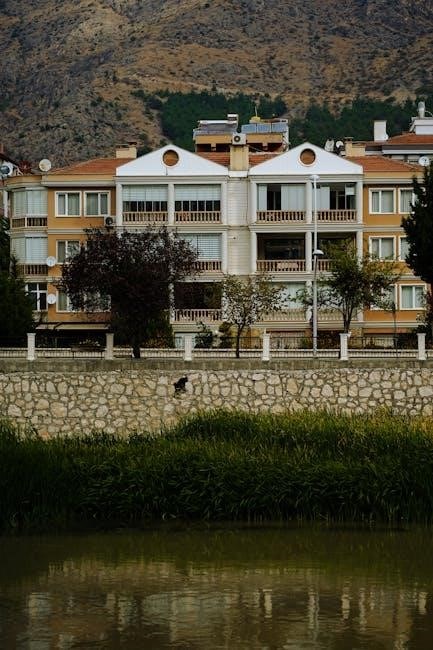
Fence Design Considerations for High Winds
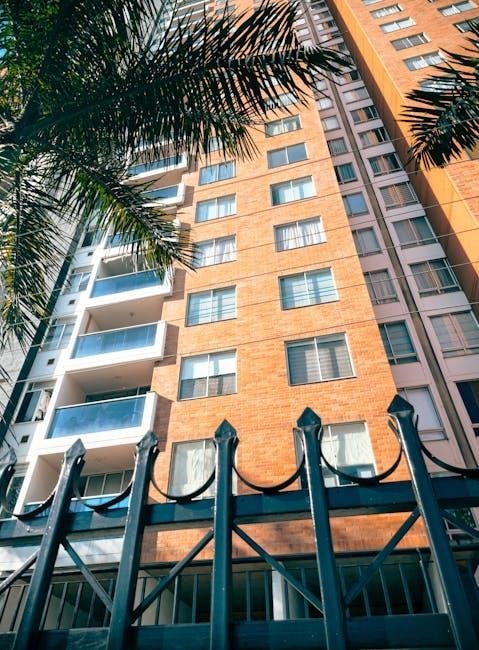
Optimal fence height, mesh size, and material selection are crucial for withstanding high winds. Durable materials like metal or wood ensure stability and minimize damage from gusts.
7.1 Optimal Fence Height and Mesh Size
Optimal fence height and mesh size are critical for minimizing wind load effects. Taller fences require stronger materials to resist bending and shear forces caused by high winds. Mesh size plays a significant role in reducing wind pressure by allowing air to pass through, thereby decreasing the force acting on the structure. Larger mesh sizes are generally more effective in high-wind conditions but may compromise privacy and security. The selection of height and mesh size should also consider local building codes, exposure conditions, and the intended use of the fence. Balancing these factors ensures the fence is both functional and durable in windy environments. Proper design helps prevent structural failure and ensures long-term performance.
7.2 Material Selection for Durability
Material selection is vital for ensuring fence durability against wind loads. Metals like aluminum and steel offer high strength-to-weight ratios, making them suitable for withstanding strong winds. Vinyl and composite materials provide excellent resistance to corrosion and weathering, maintaining structural integrity over time. Wooden fences, while aesthetically pleasing, require regular maintenance to withstand moisture and rot. The choice of material should align with the fence’s intended use, local climate conditions, and budget constraints. Durable materials not only enhance safety but also reduce long-term maintenance costs. Proper material selection ensures the fence remains stable and secure, even in extreme weather conditions. This step is crucial for balancing cost, performance, and environmental adaptability.
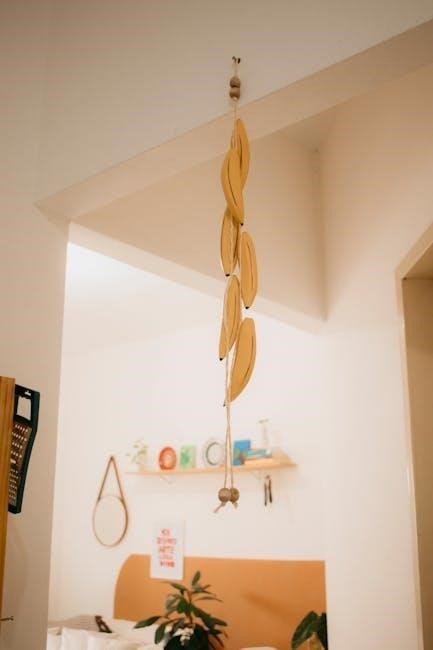
Structural Stability and Safety Factors
Structural stability ensures fences withstand wind loads without compromising safety. Proper post spacing, foundation depth, and material strength are critical to prevent failure and ensure long-term reliability.
8.1 Post Spacing and Foundation Requirements
Proper post spacing and foundation design are essential for ensuring the structural integrity of fences under wind loads. Post spacing should be determined based on the fence’s height, material, and local wind conditions to prevent excessive deflection or failure. Foundations must be deep enough to resist uplift and lateral forces, with concrete footings reinforcing the posts. Soil type and bearing capacity also play a crucial role in foundation design. Regulatory guidelines, such as those in Eurocode 1 and ASCE 7-22, provide detailed calculations for post spacing and foundation requirements, ensuring compliance and safety; Proper execution of these elements is vital to withstand wind forces and maintain the fence’s stability over time.
8.2 Factor of Safety for Fence Systems
A factor of safety (FoS) is implemented to ensure fence systems can withstand wind loads beyond calculated design pressures. This margin accounts for uncertainties in material strength, load estimation, and construction tolerances. Typically, a FoS of 1.5 to 2.0 is recommended, depending on the fence’s criticality and exposure conditions. Material selection, post spacing, and foundation strength are evaluated to meet this factor. Dynamic wind effects and potential overstresses are considered to prevent failure. Compliance with codes like Eurocode 1 and ASCE 7-22 ensures the FoS is appropriately applied, safeguarding the structure against extreme weather events and ensuring long-term reliability. Regular inspections and maintenance further support the integrity of the fence system.
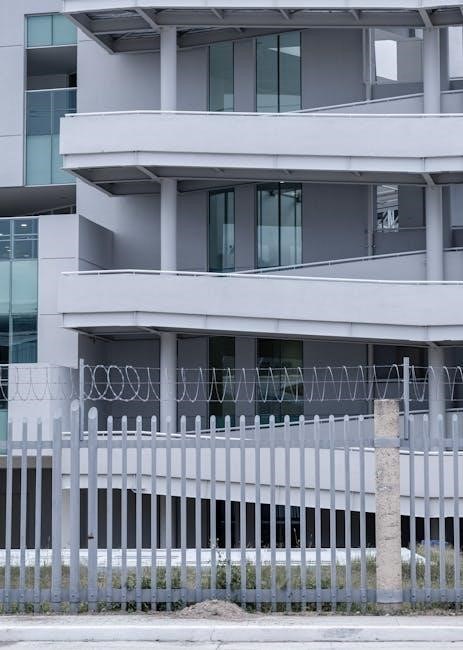
Economic and Maintenance Aspects

Economic considerations in fence design balance initial costs with long-term durability. Wind-resistant materials and regular inspections reduce maintenance needs, ensuring cost efficiency and structural longevity over time.
9.1 Cost Implications of Wind-Resistant Designs
Wind-resistant designs in apartment fences often involve higher initial costs due to reinforced materials and engineering requirements. However, these investments pay off by reducing long-term maintenance and replacement expenses. Durable materials like treated wood or metal alloys, while more expensive upfront, offer greater longevity and lower repair costs. Additionally, adhering to wind load codes can prevent structural failures, avoiding costly rebuilds. Balancing these factors ensures that the fence remains economically viable while providing reliable performance against harsh weather conditions. Proper material selection and design optimization are key to managing costs effectively without compromising safety or aesthetics.
9.2 Maintenance Tips for Longevity
Regular maintenance is essential to ensure the longevity of apartment fences exposed to wind loads. Inspect the fence periodically for damage, such as loose posts or broken panels, and address issues promptly. Cleaning debris and dirt from the fence surface prevents corrosion and maintains structural integrity. Applying protective coatings or treatments, especially to metal components, can enhance durability against environmental factors. Additionally, trimming nearby vegetation reduces wind-borne debris impact. Proper alignment and tightening of hardware ensure stability. Following these tips helps extend the fence’s lifespan and maintains its aesthetic appeal while complying with design codes like Eurocode 1 and ASCE 7-22. Consistent upkeep is a cost-effective way to safeguard against wind-induced damage.
10.1 Summary of Key Design Principles
Effective apartment fence design requires balancing aesthetics with structural integrity. Key principles include calculating wind loads using Eurocode 1 and ASCE 7-22 guidelines, selecting durable materials, and ensuring proper post spacing. Understanding geographic exposure conditions and optimizing fence height and mesh size are crucial. Regular maintenance and adherence to safety factors enhance longevity. By integrating these principles, fences can withstand harsh weather conditions while maintaining their functional and visual appeal. Future designs may incorporate innovative materials and technologies to improve efficiency and sustainability.
10.2 Emerging Innovations in Fence Design
Emerging innovations in fence design focus on enhancing durability, sustainability, and adaptability. Smart materials like self-healing polymers and shape-memory alloys are being explored to improve resilience against extreme weather. Modular fence systems allow for easy customization and repair, reducing long-term maintenance costs. Additionally, integrating technology such as wind-sensitive sensors can optimize fence performance in high-wind conditions. Sustainable materials, such as recycled plastics and bamboo composites, are gaining popularity for eco-friendly solutions. These advancements aim to create fences that are not only structurally sound but also environmentally conscious, paving the way for a new generation of fence designs that balance functionality with modern aesthetics and sustainability goals.